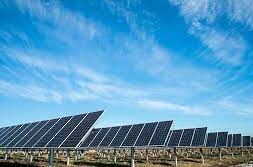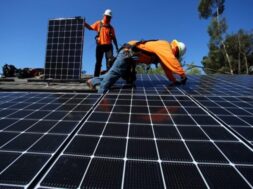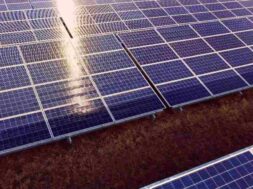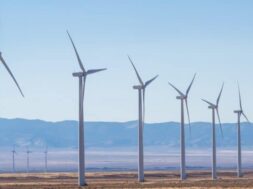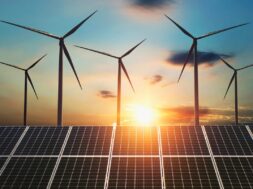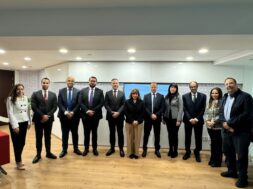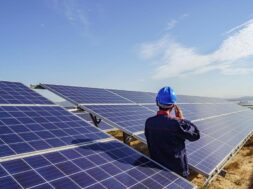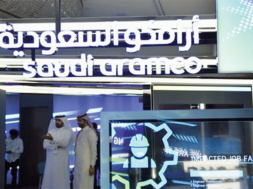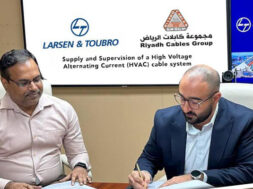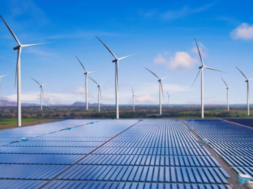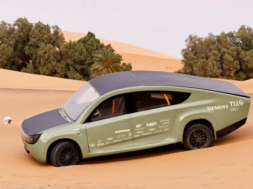
Dh80 billion project is expected to transform North African energy industry
Giant solar parks are fast becoming a feature of remote landscapes across China and India, but the latest plan to transform southern Morocco into a power super station is set to dwarf them all.
Subsea cables pinned up to 700 metres deep on the sea bed will carry almost 4 gigawatts of energy daily, nearly 3,800 kilometres from the coast of Morocco, through Spain and Portugal and into more than seven million UK homes.
Power generated from 12 million solar panels and 530 wind farms, stretched across 1,000 square kilometres of desert in the Guelmim-Oued Noun area of the North African kingdom, has the potential to supply almost five times the amount of green energy currently provided by the world’s largest solar farm in Rajasthan, India.
The 10.5GW project was founded by Xlinks First Limited in partnership with Abu Dhabi National Energy Company, better known as Taqa, and investors Octopus Energy Group, and promises to transform Africa’s energy supply.
“Xlinks is a symbol of lots of development happening across the African continent, what is different with this project is the size,” said Dr Samir Rachidi, chief executive of the Research Institute for Solar Energy and New Energies in Morocco.
“This project is beyond anything else we have seen up to now. There are several 2-gigawatt projects elsewhere, but this is more than 10 gigawatts – it is huge.
“With this scale, we have the opportunity to bring heavy industry like photovoltaic solar panels that add high value and impact in terms of employment, economic balance and growth for Morocco.
“This region has massive renewable [energy] potential, for solar and wind.”
Seven years to go
The project is scheduled for completion by 2030, and has been supported by a Dh113 million investment from Taqa, and Dh22 million from Octopus Energy.
On completion, the Dh80 billion project will become the world’s longest high-voltage direct current (HVDC) subsea cable pathway and herald a new generation of long-distance renewable energy supply.
In a recent statement, Simon Morrish, chief executive of Xlinks, said the company hoped the project would supply British households with year-round secure, affordable, and green energy.
It would also help accelerate the UK’s long-term plan to move its energy supply to more renewable solutions, he said.
With the intense year-round Moroccan sun beating down on to the arid, moon-like landscape of Guelmim-Oued Noun, solar panels have the potential to produce triple the energy supply they would in the UK.
Despite that potential, challenges lie ahead, said Dr Rachidi.
“Problems in the past have been the variability of supply, so we are looking for options with the most potential and we have that with solar,” he said.
“Some of those challenges are about land use, particularly with wind turbines.
“We need to be careful if there are national reserves or protected areas.
“These areas have low density of populations, so there is no major impact on populations but we must be aware of natural resources and complete the necessary impact studies.”
However, Dr Rachidi said, the pros surpass the negative elements and costs of this project.
“In some regions of the south there is a solid wind for 70 per cent of the time, which is exceptional.
“Morocco is trying to develop quickly – the people of this country are thirsty for sustainable economic growth. This can help us achieve that.”
Solar revolution
The 2.25-gigawatt solar farm in Bhadla Solar Park, Rajasthan in India is currently the world’s largest, followed by the 2.2-gigawatt Huanghe Hydropower Hainan Solar Park in China.
In third place is the 2.05-gigawatt Pavagada Solar Park, also in India, while the 3,700-hectare Benban Solar Park in Egypt was connected to the country’s National Grid in 2019. The latter powers more than 420,000 households.
The Tengger Desert Solar Park in Ningxia, China delivers energy to some 600,000 homes.
In the UAE, the 77-square-kilometre Mohammed bin Rashid Al Maktoum Solar Park south of Dubai continues to expand and aims to provide 5 gigawatts of energy by the end of the decade.
However, it is the project in Morocco that has given the strongest indication yet of UAE’s investment into Africa to aid the transition towards large-scale renewable energy.
Jasim Husain Thabet, Taqa’s group chief executive and managing director, said the investment shows the level of ambition to reduce carbon emissions.
“We are already working on a large-scale HVDC subsea project in Abu Dhabi, and we own and operate one of the world’s largest solar PV plants,” he said.
“This investment offers the chance to bring both our infrastructure and renewable power expertise to the table to benefit the UK and Morocco.”
While the subsea cables are to be built in the UK and laid down from a specialised vessel in stages, about 10,000 new jobs are expected to be generated in Morocco during construction, leading to significant foreign direct investments in the country.
Energy shift
Speaking on the sidelines of Gitex Africa, the UAE technology conference held outside of Dubai for the first time in Marrakech, Omar Al Olama, Minister of State for Artificial Intelligence, Digital Economy and Remote Work Application, said the project had the potential to transform North Africa.
“Most countries are focusing on the here and now, through this project the UAE and Morocco is focusing on the world,” he said.
“We will do what is right economically and socially to empower systems across the African continent to build a connection to Europe, and create better opportunities.
“There are multiple programmes and partnerships developing between the UAE and Morocco, some are government to government, some are business to government.
“One of which is the incredible work being done laying sub-sea cables to connect Africa and Europe.
“This will provide the artery of connectivity required to empower all these companies that are going to be digitalised in the future.”
